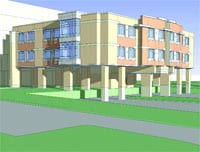Critical Needs Mercy Breaks Ground on New Intensive Care, Ambulatory Surgery Units
Technology in health care moves quickly, says Dr. George Karras — so much so that the realistic lifespan of many medical facilities is only about 25 to 30 years.
By that measure, the construction of a new intensive care unit at Mercy Medical Center could be considered overdue.
“Our ICU was built in the 1970s, and it just doesn’t meet code for today,” said Karras, president of Mercy’s medical staff. “There are issues of sleep deprivation, infection-control issues, privacy issues — and all these concerns have really come to the forefront in the past five to 10 years in critical-care medicine.”
Those issues — and then some — will be met by Mercy’s new, $16 million intensive care and ambulatory surgery building, set to open in late 2008. The hospital recently hosted a groundbreaking ceremony for the 30,000-square-foot addition.
“This building will be spectacular,” Karras said. “And I think this shows Mercy’s commitment to the community, in particular its commitment to taking care of some really ill people.”
This month, The Healthcare News takes an early look at what’s in store as construction begins on Mercy’s Carew Street campus.
Cutting Edge
Vincent J. McCorkle, president and CEO of the Sisters of Providence Health System, of which Mercy is a part, spared no enthusiasm during the groundbreaking ceremony.
“When it is completed, this will be the most modern, state-of-the-art facility in all of Western Mass.,” he told a crowd of about 150 hospital staff, trustees, and community leaders. “The facility will then match the excellence and the competencies and skills of the staff who care for critically ill patients at Mercy.”
The plan will double the existing ICU space, extending the unit beyond the second level of the existing building and providing cover to the patient registration entrance on the ground floor. The space will boast 280-square-foot private rooms for each ICU patient, featuring direct access to windows or natural light. Both the patient rooms and common areas will offer more space for family members than the current unit allows.
“This new ICU will be incredible in terms of size, space, traffic flow, and visibility from the central nurses’ station to the individual rooms,” Karras said. “And those rooms will be state-of-the-art. In fact, we expect that this ICU will still be state-of-the-art 10, 15, even 20 years from now.”
Karras explained that the floor plan of the building was designed with patient care, safety, and privacy in mind, and a feeling of spaciousness and light were critical elements in meeting that goal.
Take privacy, for instance — a major consideration for hospitals in the era of the Health Insurance Portability and Accountability Act (HIPAA).
“The current ICU, as it exists, has a number of rooms that are wide open,” Karras told The Healthcare News, explaining that all the rooms in the new ICU will be reasonably private. “We also thought in terms of the size of rooms, storage space, traffic on the floor, the amount of light that comes into the rooms — all those issues needed to be addressed.”
“These are extremely critical factors to me and to the entire staff,” he continued. “It goes to the whole mind-body connection. That is, if the patients can be in a place of peace, and the staff can work in a place of peace, from a visual and auditory context, it becomes a better place to work and a better place for people to begin to heal.”
The new ambulatory surgery unit, which will occupy the level above the ICU, will feature an all-new post-acute care unit and a pre-op suite that is entirely separate from the recovery suite, one of the ways the unit will stress patient privacy. The plans also include new private recovery rooms and the modification of walls to improve visibility between patients and staff.
“These improvements will allow us to become even more efficient in delivering patient care through enhanced visual and technological monitoring, as well as better access to patients and supplies,” Karras said, adding that the changes will also make patients’ family members more comfortable.
Seeing Patience
The comfort of the Mercy staff over the next two years of construction is another story, of course. But hospital operations will continue uninterrupted during that time. Meanwhile, Dr. James Fanale, Mercy’s COO, acknowledged that staff will be inconvenienced during the construction. “It will not be pretty or easy, but bear with us,” he told the gathered crowd at the groundbreaking.
That said, Mercy’s employees have gotten behind the project, personally donating more than $70,000 toward the renovation over the past two years. “Our commitment to being the best is there,” Fanale said. “Now we will have the facility to match the quality.”
The project will allow for 14,000 square feet of shell space below the new ICU for future expansion, should that ever become necessary. And Mercy is certainly looking forward — not just with this project, but in several facets of health care, having recently opened a new breast center, launched an interdisciplinary lung cancer program, and added cutting-edge stereotactic radiosurgery for brain tumors, among other efforts.
The ICU and ambulatory surgery unit will boast state-of-the-art technology as well. But in speaking with The Healthcare News, Karras kept coming back to the design elements that seem aesthetic, but actually impact care on a certain level.
“The interior design, the floor space, the lighting — all those things have been taken into consideration to meet the highest standards in terms of psychological as well as physical healing,” he said. “The architectural design of this ICU is the best I’ve seen, and we’ve looked at a lot of ICUs.”
He’s hoping that Mercy’s new unit will look just as good 25 years from now.




Comments are closed.